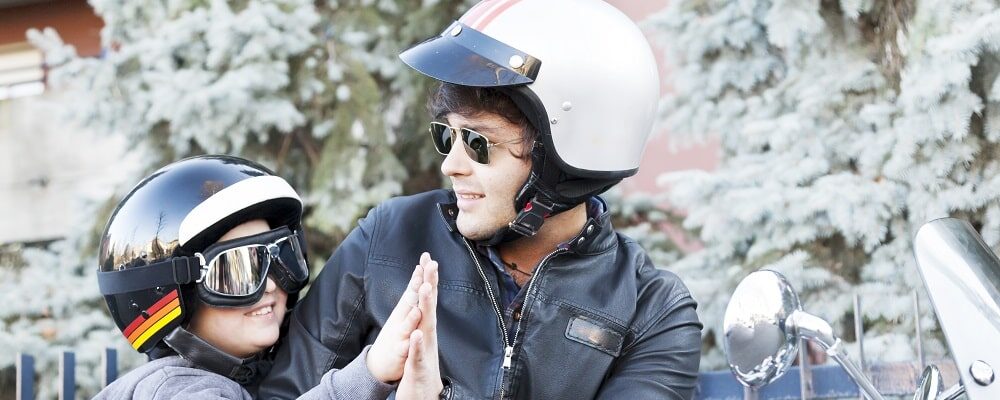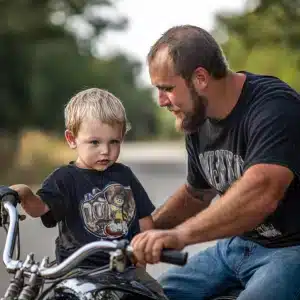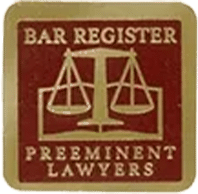
For motorcyclists, the only thing better than being on their bike is being on their bike with their child. Passing on your passion for motorcycle riding to your child can be an exciting and highly rewarding experience. However, when you do so, you must make sure that you follow proper safety precautions.
Oklahoma has no laws that establish a minimum age for motorcycle passengers. So, when you think your child is ready, you can take the child out for a ride. Still, you should be aware of other laws that are meant to protect a young person if they should ever get into a motorcycle accident in Oklahoma.

Hurt in A Motorcycle Accident?
Contact us today for your free & confidential case review. Our team will help you get the compensation that you deserve.
How Should You Prep Your Motorcycle for Child Passengers?
Not all motorcycles are designed to carry passengers. For instance, some bikes have a seat that simply accommodates only one person, or it may have no foot pegs or hand straps for passengers. Even if your motorcycle is designed to carry two people, you should make sure that you prep it in order to ensure your child’s safety when riding on the back of it.
First, you should check and adjust the bike’s suspension and tire pressure. This will allow you to keep more control over the bike, and it will handle better on the road. Something you should always do before going for a ride – with or without a passenger – is to check that the headlight is clean and working as well.
Lastly, you should review your owner’s manual. Manufacturers sometimes include setup tips and other recommendations when riding with passengers. It will also specify the weight limit of the bike. You should make sure that you and your child passenger don’t exceed that limit.
What Equipment Will You Need to Ride with a Child?
If you are riding with a child, the child must wear a helmet. Oklahoma law states that anyone under the age of 18 must wear a proper helmet at all times when on a motorcycle.
A proper helmet should have enough stiff interior padding to ensure the child’s head and neck are supported at all times. The helmet should also include a full-face shield. This shield will provide as much protection as possible for your child, and it will also avoid the need for extra gear such as eye protection.
Your child’s helmet must have U.S. Department of Transportation (DOT) certification. A sticker on the helmet will indicate it if meets DOT standards.
Once you have picked out the perfect helmet for your child, you will need to check the sizing on a regular basis. Children grow quickly. As the child’s head gets bigger, the interior padding in the helmet can become compressed. If this occurs, the helmet will not provide proper protection.
Your child should wear additional gear that will help to keep the child safe on the bike. Riding boots or shoes will help the child to increase his or her grip on footrests, while gloves will protect the child’s hands in case of an accident or fall off the bike.
How Should You Prepare a Child for Riding?
You likely took many precautions before you got on a motorcycle for the first time. You should do the same for your child.
Balance is the key to safely operating a motorcycle and riding as a passenger. To teach balance, you should let your child sit on the bike before it is even started. Use the kickstand or center stand, at first, to allow your child to become comfortable just sitting on the bike. Then, remove the stands and sit on the bike with your child on it. This will provide less stability, and it will allow your child to learn how to maintain his or her balance on the bike.
While practicing balancing, talk to your child about bike basics. Instruct the child that, when going for a ride with you, the child should get on the bike only once you have started it. Have the child practice sitting forward as he or she would when the bike is in motion. Emphasize the importance of facing forward at all times.
Ask your child to hold the straps and instruct the child on how to get the best grip. You should remind your child that it is harder to stay on a bike when taking turns. So, the child will need to have a tighter grip during those times. Children have to know how to lean into turns as well. You can sit on the bike with the child, even when it is not turned on and demonstrate how to do that.
Also, make sure your child uses the footrests at all times. Point out the muffler, chains and any other parts of the bike that could become hot when the bike is in use. Tell your child to keep his or her legs away from these parts to avoid burns.
Reinforce to your child that, while being on a bike is an exciting thing, your child must never make any sudden movements or shout while riding. You have to pay attention to the road as well and avoid any distractions.

Hurt in A Motorcycle Accident?
Contact us today for your free & confidential case review. Our team will help you get the compensation that you deserve.
Should You Take Special Precautions with a Child Rider?
Preparing your child for his or her first trip on a motorcycle is important. It is essential that you take additional precautions when riding with the child. Being more cautious in all aspects of operating a motorcycle with a child passenger will help to ensure that both of you are kept safe.
When taking turns or corners, you should go a little slower. The child will be still getting used to leaning into turns and moving with the bike. Also, accelerate and decelerate slower than you normally would. Again, children are just becoming accustomed to these movements. You should also allow more distance between you and other drivers and never speed.
Lastly, keep your trips short at first. Brief trips will allow your child to gradually get the feel of a bike. It will keep the child more comfortable and allow the child to be prepared for an eventual long trip.
Get Help Today from an Experienced Oklahoma Motorcycle Accident Lawyer
As a motorcyclist, you may go to great lengths to keep you and your child passenger safe. Unfortunately, other motorists don’t always act with the same care. If you have been hurt in a motorcycle accident, you should get the help you need from our experienced Tulsa motorcycle accident attorneys at Edwards & Patterson Law. We will fight for the compensation you deserve. Contact us online today to learn more in a free consultation.
Last updated Tuesday, February 18th, 2025













